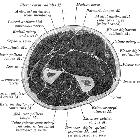Nervus ulnaris






The ulnar nerve is one of the terminal branches of the brachial plexus and has motor and sensory supply to the forearm and hand.
Gross anatomy
Origin
The ulnar nerve originates as a terminal branch of the medial cord of the brachial plexus with nerve root fibers from C8-T1.
Course
Arm
In the arm, the ulnar nerve runs medial to the axillary artery and subsequently the brachial artery on the coracobrachialis muscle in the anterior compartment. The nerve passes to the posterior compartment through the medial intermuscular septum distally running with the superior ulnar collateral artery. Further on, it runs between medial head of triceps brachii muscle and the medial intermuscular septum to pass posterior to the medial humeral epicondyle in the superficial condylar groove (cubital tunnel).
Forearm
The ulnar nerve enters the forearm from the arm via the two heads of flexor carpi ulnaris (FCU) muscle. It subsequently lies superficial to flexor digitorum profundus and deep to FCU and medial to the ulnar artery. At the wrist, the ulnar nerve runs lateral to the tendon of FCU.
Hand
The ulnar nerve enters the hand superficial to the flexor retinaculum and inside Guyon's canal. Then it divides into its terminal branches at the level of the pisiform bone.
Prior to passing the flexor retinaculum at the wrist, the ulnar nerve gives off the dorsal cutaneous branch.
Branches
Terminal branches
- dorsal cutaneous branch
- palmar cutaneous branch
- branch to palmaris brevis
- superficial terminal branch
- deep terminal branch
Supply
The ulnar nerve has both sensory and motor supply:
- motor
- flexor carpi ulnaris
- flexor digitorum profundus (medial half)
- hypothenar muscles (abductor digiti minimi, flexor digiti minimi brevis, opponens digiti minimi)
- 3 and 4 lumbricals
- palmar and dorsal interossei muscles
- flexor pollicis brevis (deep head)
- adductor pollicis
- palmaris brevis
- sensory
- articular innervation to elbow, wrist, carpal and phalangeal joints
- cutaneous innervation to ulnar aspect of the hand, specifically the 5 digit and the medial half of the 4 digit.
Variant anatomy
- may arise from the 7th and/or 8th cervical nerve roots only
- may pass in front of the medial epicondyle of the distal humerus
- Riche-Cannieu anastomosis: communication between the recurrent branch of median nerve and deep branch of ulnar nerve in hand
- Martin-Gruber anastomosis: communicating nerve branch between the median nerve and the ulnar nerve in the forearm
- may supply all the thenar muscles
- branch to the dorsum may be absent
Related pathology
- ulnar nerve impingement
- ulnar nerve subluxation (elbow)
Siehe auch:
- Ulnariskompressionssyndrom durch schnappenden Musculus triceps
- Schwannom Nervus ulnaris
- Dislokation Nervus ulnaris
- Neuritis Nervus ulnaris
und weiter:

 Assoziationen und Differentialdiagnosen zu Nervus ulnaris:
Assoziationen und Differentialdiagnosen zu Nervus ulnaris:


